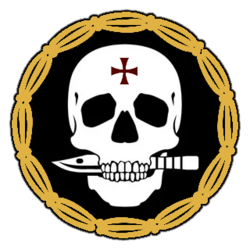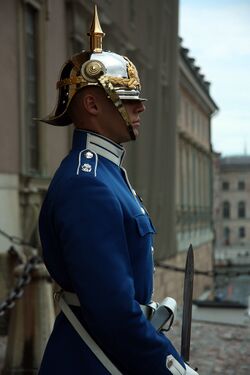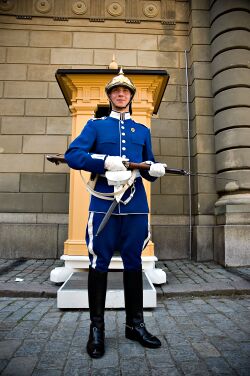Livgardet: Difference between revisions
No edit summary |
No edit summary |
||
| Line 42: | Line 42: | ||
The Gardes du Corps is composed of several small battalions, each numbering approximately 300 soldiers. Although nominally considered as light infantry, the regiment additionally possesses attached motorised provided by ''Panserlehrbataillon 91'', an elite armoured formation, and an attached aviation component. The regiment is capable of deploying individually without either component, but with full complement is supported by its light armour and airmobile capabilities. | The Gardes du Corps is composed of several small battalions, each numbering approximately 300 soldiers. Although nominally considered as light infantry, the regiment additionally possesses attached motorised provided by ''Panserlehrbataillon 91'', an elite armoured formation, and an attached aviation component. The regiment is capable of deploying individually without either component, but with full complement is supported by its light armour and airmobile capabilities. | ||
* 1st Battalion '' | * 1st Battalion ''Det Königsseigen'' | ||
* 6th Battalion ''Fierté de Vannes'' | * 6th Battalion ''Fierté de Vannes'' | ||
* 7th Battalion ''De Kalde'' | * 7th Battalion ''De Kalde'' | ||
Revision as of 05:22, 1 January 2022
| Gardes du Corps | |
|---|---|
 | |
| Active | 10 May 1492 - Present (532 years, 6 months) |
| Country | |
| Type | Infantry |
| Size | 1,653 personnel |
| Part of | Acrean Army |
| Headquarters | Joint Forces Base Königsbrück, Steiermark, Acrea |
| Motto(s) | Det tid er kominn (Old Acrean: The time has come) |
| Commanders | |
| Current commander | Lieutenant General Andreas von Kreuthier |
The Gardes du Corps, also referred to as the Livgarde, is an elite infantry unit of the Acrean Army and its longest continuously operational military unit. Formed initially as the personal bodyguard of the Acrean Monarchy, the Royal Guards grew into an elite frontline infantry regiment, serving dual roles both as the royal guard and as an elite tactical reserve in battle. Today, the regiment serves ceremonial, protection, and operational roles. Composed entirely of veteran soldiers, it serves an important role as an elite light infantry regiment and is considered a part of Acrea's special operations forces. Despite this, it does not conduct clandestine operations. A separate unit of special infantry, the Jagdkommando, was created to fulfill such a role; the 1st Battalion of Jagdkommando is composed of Livgarde. The Gardes du Corps maintains extremely strict standards related to a soldier's own performance and conduct.
History
The regiment was formed in 1492 to serve as the monarchy's bodyguard. This role was previously filled predominantly by Templars, a group with the regiment recruited extensively from. Although deliberately being created to serve the monarchy, soldiers of the regiment quickly adopted a clear public service function early in the regiment's history, and became a component of the guard at many key government buildings in Acrea including the Reichstag. Royal Guards had to meet numerous requirements, and were generally handpicked by an officer appointed by the monarch as well as the regiment's commanding officer. Initial requirements included having at least 10 years of service, experience in battle facing the enemy, and being under the age of 35. Members of the regiment gained a reputation for physical stature, however there was never any official height requirement associated with being selected for the regiment, and only some evidence exists to support the idea that taller soldiers were deliberately sought after for recruitment. Veterancy and prowess were considered the most vital considerations when recruiting a soldier into the Royal Guards, and continue to be today.
In exchange for their service, Royal Guards received special privileges including increased wages. Members of the regiment today likewise receive greater pay due to their service in the unit, which is persistent throughout their entire military career even if they eventually leave the unit. Since its formation, a certain prestige has been associated with serving in the regiment; this has spread into the formation of Guards-only veterans groups, as well as exclusive officers' clubs and taverns in their home garrisons. The regiment has served in almost all of Acrea's major wars since 1500, including recent conflicts such as the Zemplen War and Midsummer War.
Requirements and Training
Many of the original requirements stipulated in the creation of the Gardes du Corps are upheld in the modern day. The most important is experience; recruits are required to have either three years of service, or be a combat veteran, in order to be even considered for recruitment. Extremely high physical standards and mental aptitude requirements must also be met. Training for the regiment consists of an additional 15-week course, divided into two stages: the first stage consists of the first nine weeks and is devoted to combat, survival, and field skills training. This is followed by a week-long recovery period. Completion of this training is considered a "checkpoint"; soldiers receive a certification for successfully completing this combat training, which is considered to be like a "waiver" and makes them eligible for service within other certain units such as the Jagdkommando. The second stage is the subsequent five weeks, which are devoted to ceremony, drill, and protection training.
Members of the 9th Battalion of the Gardes du Corps, designated as Dragoons, undergo an additional several weeks of equestrian training.
Organisation
The Gardes du Corps is composed of several small battalions, each numbering approximately 300 soldiers. Although nominally considered as light infantry, the regiment additionally possesses attached motorised provided by Panserlehrbataillon 91, an elite armoured formation, and an attached aviation component. The regiment is capable of deploying individually without either component, but with full complement is supported by its light armour and airmobile capabilities.
- 1st Battalion Det Königsseigen
- 6th Battalion Fierté de Vannes
- 7th Battalion De Kalde
- 8th Battalion Den Vieille Garde
- 9th Battalion Dragoner der Königin
Uniforms and Equipment
Field Uniform and Equipment
As an elite combat unit, the Gardes du Corps have access to a wide variety of different uniform types, patterns, and equipment. Traditionally, regimental field dress consisted of standard Acrean olive-drab grey field uniforms until the mid 1980s, when the unit transitioned to the use of M/83 Waldflecktarnmuster and M/85 Nordtarnmuster uniforms. The standard uniform style used by the regiment is Typ-4B. It consists of a more fitted blouse and trousers than the regular army's Stridskleidung Typ-1A, though uses the same combination button-and-zipper fastening system to close the blouse as the Typ-1A. The uniform follows the regular army's Typ-2A uniforms by forgoing the use of shoulder boards on the uniform for the display of rank and instead uses a simple hook-and-loop patch on the front upper torso to display rank. Soldiers entering the regiment from the regular army, however, do often note missing the shoulder boards for fastening their berets in place when not wearing the headpieces, something which is rectified on the Typ-4C uniform. The uniform also follows the Typ-2A's shoulder pockets with additional hook-and-loop sections for attaching unit identification.
Although Typ-4B serves as the standard work uniform, actual uniforms worn for field use can vary widely, with soldiers in the regiment given a vast selection of approved contracted clothing to choose from, much like other elite combat units. Combat equipment for soldiers of the regiment can vary widely from soldier-to-soldier, as they can select from both issued kit as well as commercially-produced combat equipment that is tested and approved by the Ministry of Defence via the MAES system (which must rated at at least MAES Grade III to be approved for use by Acrean troops). The regimental quartermaster may acquire this sort of personal equipment for the regiment for issue to its troops, or they may acquire it personally. In the present, the regiment makes predominantly of M/15 Multitarnmuster pattern for its uniforms and kit and was one of the first units in the Acrean Army to transition to the new pattern. Soldiers of the regiment deployed during the Midsummer War in 2015 wore the pattern during combat operations. The regiment makes use of Army-standard small arms, with the Sturmgevär M6 as its standard rifle.
Due to it being considered a special infantry unit and a part of Acrea's special operations community in its combat roles, the Gardes du Corps has historically had access to the Acrean military's premier equipment. Likewise, its input and feedback on emerging or existing equipment is highly valued. Historically this has been seen primarily in its adoption of new armaments, however in the present day this role has extended to the use of new devices and technology. The Gardes' 6th Battalion was considered vital in the development of Acrea's currently fielded soldier systems, as it was experimentally equipped with the systems for field trials while it was still during development. The extreme conditions which troops such as Guards are expected to face are considered an important benchmark to be met for any soldier-worn systems and equipment that the Acrean Army fields, and so they provide a valuable service as a testbed for developing technologies.
Parade Uniform
The current uniform worn by the Gardes du Corps is a slight modification of its 1882-pattern uniform. The uniform consists of a tunic and jodhpurs in Acrean royal blue, which for some officers' uniforms is replaced by the slightly darker Acrean imperial blue. The tunic is accented with a white collar, white buttons, and white piping, and secured with the use of a white belt. The belt also holds the Guard's cartouche box, bayonet scabbard, sword, and a holster for a pistol if they are carrying one. The standard belt and cross belt are plain white; noncommissioned officers will have a silver cross-braided cross belt, while officers will have a gold cross-braided cross belt.
Additionally, both officers and noncommissioned officers will possess additional golden details on their kit. Officers will have a white holster with gold metal detailing alongside an issued ceremonial P01 pistol, while noncommissioned officers will instead have a plain white holster with golden metal detailing on their cartouche box. The jodhpurs possess a single white stripe along the side of each leg, and are tucked into black riding boots. On some occasions, the jodhpurs and riding boots may be replaced with slightly tapered solid blue trousers and infantry parade boots.
The standard headgear is a polished, silver pickelhaube with golden accents and a black varnished leather chinstrap; the pickelhaube being one of the most iconic pieces of Acrean military headgear from the late 19th and early 20th century. For parade purposes, the spike on top may also be topped with a white plume, or the pickelhaube may be replaced altogether by a black bearskin. Ceremonial armaments vary; Guards standing on duty will often carry an M1895 rifle, while mounted Guards on patrol will carry M1895k carbines as their ceremonial weapons. However, it is not uncommon for Guards on foot to also be carrying the carbines as well. Guards on foot will always have their bayonets affixed to the rifles, while mounted Guards will not. All weapons carried by Guards, except when actively on parade, are in fact loaded- Guards are trained in the manual-of-arms for the older weaponry if necessary to use it, but will generally also be carrying a modern handgun for use in an active security situation. Likewise, each shift for a Guard on duty is accompanied by a shift of an additional crisis team capable of responding to security emergencies whenever necessary. At any given station, Guards will also have armed police nearby to call upon in an emergency.


